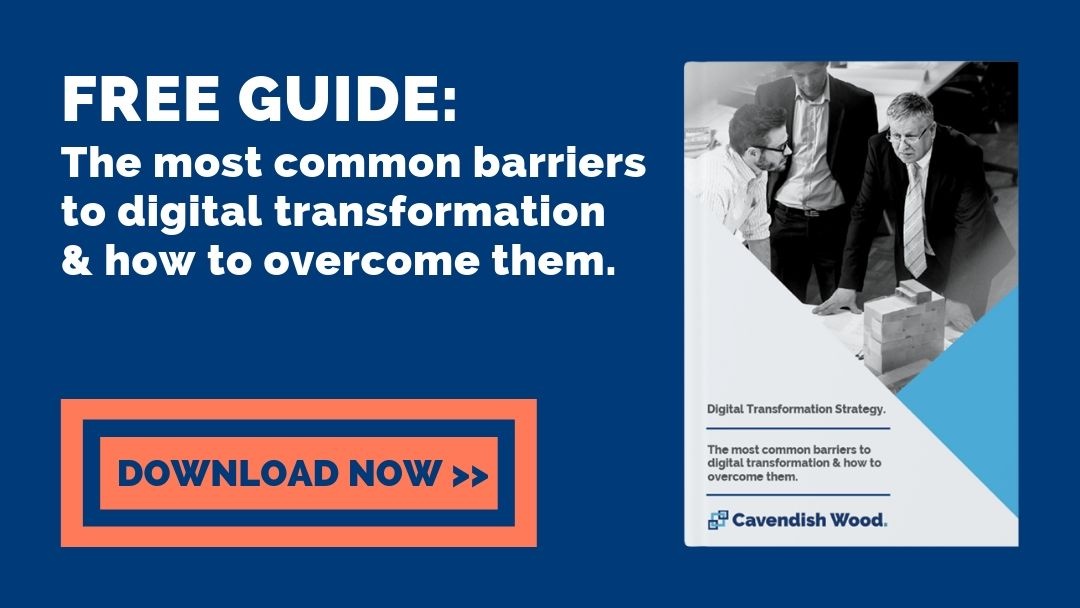
Digital transformation often means different things to different people and the term has now most definitely achieved ‘buzzword’ status.
Unfortunately, the upshot of ‘digital’ slipping into jargon and the plethora of interpretations of the term means that CIO’s and Delivery Leads risk making poor decisions, based on poorly understood principles and could lead to costly mistakes.
This often means that the end users and customers of your business suffer a continually frustrating and negative experience when engaging with you, and that you are likely to have multiple technology-driven IT upgrade programmes in your portfolio with little benefit to your customers or the company, leaving you too feeling frustrated and left behind by the competition.
Understanding the key objectives of digital transformation will ensure that you can start to plan for digital transformation in the right way, with a much better chance of success for both you personally, and your company and its customers.
So, what are the key objectives of a digital transformation?
The answer may surprise you. If you’re thinking it’s the implementation of new,cutting-edge technology then you’re not looking at things in the right way.
Sure, technology is pretty key to digital transformation but it’s not the whole picture. Think about what the most important thing to any company is.
Is it the staff?
Is it the board?
Is it the bottom line?
I’d say a resounding “No” to all of these.
No company exists to serve itself or any internal needs.
Every single company or organisation exists to serve the external needs of it’s customers. This may sound obvious, but the bigger the company has grown and the longer it has existed, the further away from this basic principle it will have become.
ISSUE #1 – Strategic Drift
The first key issue for many companies, particularly large ones, is that the founding mission, the very statement of intent the founders of the company created the company to achieve is likely long forgotten. Because often these companies are profitable, the misalignment to the founding mission is never questioned and it’s the customers who pay the ultimate price in terms of diminished service and broken promises.
Think about how the board of a large, publicly traded company makes decisions based on pleasing its investors instead of its customers, or a government body that seeks to elicit praise and political gain instead of delivering genuine change for the better of its citizens. These are both common examples of how a huge gap can form between the original purpose or mission of the organisation and its customers’ needs in the here and now.
ISSUE #2 – The threat of new ‘agile’ entrants in core markets
The second key issue for every company is reacting to digital technology and newer, more agile digital competitors. Services must be delivered to clients and consumers via a seamless digital experience. Because if you can’t achieve this, then your organisation and your non-agile-competitors will start to lose business quickly.
These are all external conditions which create the need for a company to digitally transform.
All companies are faced with these rapidly changing external conditions which are being shaped by digital technology and the consumer expectation which is aligned to this technology revolution. Of course, this expectation also bleeds into our professional lives and so we expect and need much more digitally advanced experience both as consumers and as business clients.
The No.1 Digital Transformation Objective to Rule Them All
Therefore, the first and most critical objective of any company’s digital transformation is:
To better meet its customers’ needs and realign to its original founding mission.
This needs to be ground-zero for any digital transformation as it provides the focus for the whole strategic business change, not just the sub-projects and programmes that take place.
Without over-egging this point, this is the point.
Focussing on this key objective will mean your company’s digital transformation will:
- Increase revenue and profit margins: A bigger share of existing markets and access to new ones combined with lower costs of acquisition.
- More efficient and cost-effective operation: More collaborative working, lower operating costs due to new ways of working and technology
- Become THE market threat: You’ll have better products and services than your competitors. You’ll have the ability to rapidly move to meet new market needs or solve the market pain.
To achieve the above results there is a second critical objective of digital transformation and that is:
To become a company that is more adaptive to change itself.
Which is achieved by putting new ways of working in place, that ensure your company is able to maintain a process of continual, iterative change.
This new mindset must be at your company’s core and is a huge ask for most. It involves changing attitudes entirely and is almost certainly the biggest challenge of any transformation.
So, there are two key objectives to any digital transformation, neither of which are technology focussed but none the less will require technology to support them to be successful.

